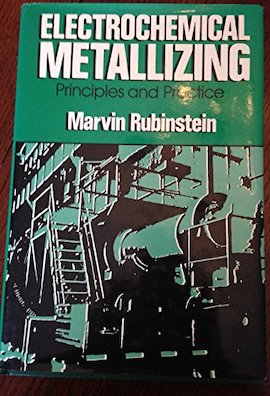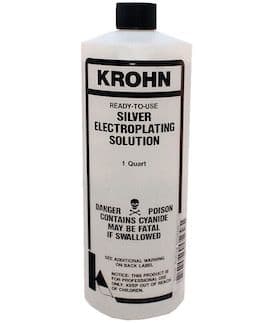
Curated with aloha by
Ted Mooney, P.E. RET

The authoritative public forum
for Metal Finishing 1989-2025

-----
What makes up silver plating solution?
Current questions and answers:
Q. Sir we can do silver to silver make up solution?
Mohan Bondre [returning]- Jalna India
June 20, 2021
June 2021
? Hi Mohan. Sorry but your message is too short for me to understand. I apologize but don't know what you are asking. But the article in the Metal Finishing Guidebook referenced below mentions the main ingredients in four different non-cyanide processes.
Luck & Regards,

Ted Mooney, P.E. RET
Striving to live Aloha
finishing.com - Pine Beach, New Jersey
Q. For some brush plating methods the wand must be made of the metal being plated, e.g., a copper wand (instead of SS) for plating copper unto another metal. So, while silver brush plating kits contain a SS wand for use with a silver solution, would a better result be obtained if a silver wand were used instead of SS? It seems that would make the solution go farther. My experience has been that the silver solution gets weak very quickly and does not go as far as the supplier claims.
Thanks!
Hobbyist - Rock Hill, South Carolina
June 25, 2021
A. Hi Charles. On the one hand, trying to 'improve' a commercially available process often doesn't work out well; a change may shorten rather than extend it's life :-(
But on the other hand, yes, soluble silver anodes are commonly used in silver plating, and it's not that big a deal if it doesn't work :-)
Luck & Regards,

Ted Mooney, P.E. RET
Striving to live Aloha
finishing.com - Pine Beach, New Jersey
June 2021
Q. I have the Krohn brand Silver Electroplating Solution, Stainless Steel anode plate (turns out for gold, so will order correct one), and Tivaclean cleaning concentrate. I have a Jinwen rectifier machine for Electroplating. I need advice on the settings for the rectifier.
Please help with advise or instructions on where I can get those instructions. Thank you in advance. Linda.
Hobbyist - El Paso, Texas
July 6, 2021
A. Hi Linda. You should get the datasheets for the cleaning solution & plating solutions, and the operating manual for the rectifier from the manufacturers of each. You can get general instruction on silver plating from the on-line version of the Metal Finishing Guidebook, as previously noted.
But what exactly are you trying to do? Plate copper or brass jewelry, plate stainless steel, plate aluminum, re-plate flatware, do electroforming, repair electrical contacts? There are many books about electroplating, and each has a chapter(s) of many pages on silver plating, covering the gamut of situations; so you have to tell us what you're trying to do so we know which of those pages aren't relevant to your needs :-)
Luck & Regards,

Ted Mooney, P.E. RET
Striving to live Aloha
finishing.com - Pine Beach, New Jersey
July 2021
⇩ Related postings, oldest first ⇩
Readers: so that we can help you, not accidentally mislead you, please start with "who you are, what you do, and why you want to know".
• For students & parents like Celeste, the important thing to do is to warn you to Stop! Violently poisonous silver cyanide processes are utterly unacceptable for home or school projects!!
• Decorative silver electroplaters need to be advised that non-cyanide processes were designed for electronics applications and may not deliver quite the aesthetics your customers expect.
• Platers should understand the many reasons other professional platers rarely make up their own plating solutions.
• For process suppliers we must guard against crowd-sourcing of industrial espionage; we don't know the motivations of responders on this no-registration site and have to be cautious about postings which, while helpful, may blow trade secrets..
Q. My son is doing a research project in electroplating silver plated objects. We have determined that the silver electroplating solution is made up of either silver nitrate or silver chloride. Can anyone tell us what makes up the other parts? What liquid is added to the silver material. Also he needs to know the parts measurements (for ex. 1 part silver nitrate to 2 parts water etc.)
Thank you
Celeste Butler (Mom with no chemical knowledge)
Celeste Butler- Brooklyn New York USA
2000
A. The basic ingredients of a conventional silver plating bath are silver cyanide and sodium cyanide. Other ingredients are added for better conductivity, brightness, etc. but are usually proprietary (composition not published).
There are non-cyanide baths available, but not as widely used, that use organic salts of silver. Again, the exact composition is proprietary, but some contain succinates.
Hopefully you are not considering making up one of these for home use or in a school project. They are toxic and heavily regulated.

Bill Vins
microwave & cable assemblies - Mesa (what a place-a), Arizona
2000
A. Celeste,
The response by Mr. Bill Vins above is indeed correct. The silver plating baths used in industry are highly toxic and contain cyanide.
However, some school demonstrations use a liquid solution of silver nitrate to put a thin immersion coating of silver on copper parts (in many cases, pennies). I still use the caution from Mr. Vins. Silver nitrate is considered an oxidizer and MUST be used only with direct supervision of a Chemistry Teacher. Also, most schools have stringent rules concerning what chemicals may be brought onto the premises. Questions should always be phoned into the school office first, for permission to proceed further.
Electroplated silver can be deposited with much greater thickness than immersion deposits. Immersion deposits normally lack good adhesion, and are not desirable for most professional Surface Finishers.

Ed Budman [dec]
- Pennsylvania
With deep sadness we advise that our good friend Ed passed away Nov. 24, 2018
2000
!!
I've seen several questions on the forum regarding the formulation of homemade silver plating solutions, especially for touch-up applications, repairs, etc. Well, I did a little research recently because I needed to do some silver brush plating, and it turns out, that a simple solution of silver nitrate is all one needs to do satisfactory silver plating. No cyanide based solutions, or "Proprietary" (seems to be an important word around here, LMAO) formulas are needed. After a couple of on-line purchases, I was able to determine the constituents of the silver brush plating solutions of three of the larger retailers of said products. (Sometimes working at a place with an in-house analytical lab has its benefits) two out of the three use nothing more than a solution of silver nitrate. That's it. No brighteners, no nothing. Generally, the solutions had a density of around 1.2 - 1.25 which works to about 25% to 30% nitrate in the solution. I found this quite funny, since I've seen posts here on this forum on more than one occasion from "experts" that claim that silver nitrate flat out will not work as a plating solution. Well, I can tell you from research, and now from experience, that it does indeed work quite well.
I just thought I would throw that out there for anyone interested.
Hobbyist - Atlanta, Georgia, USA
October 9, 2012
![]() Thanks, Derek. Most "instant re-silvering" dips are silver nitrate or based on silver nitrate (see FAQ: Silver Plating at Home"); it is interesting to learn from you that pure silver nitrate proved acceptable for brush plating. Our mission is certainly not to crowdsource industrial espionage, so discussions need to remain generic, not aimed at blowing trade secrets.
Thanks, Derek. Most "instant re-silvering" dips are silver nitrate or based on silver nitrate (see FAQ: Silver Plating at Home"); it is interesting to learn from you that pure silver nitrate proved acceptable for brush plating. Our mission is certainly not to crowdsource industrial espionage, so discussions need to remain generic, not aimed at blowing trade secrets.
Well over 95% of all silver plating is cyanide based as it has been for a hundred years, but brush plating involves a different dynamic and perhaps it works. Silver nitrate probably will not adhere properly in tank plating. Thanks again.
Regards,

Ted Mooney, P.E.
Striving to live Aloha
finishing.com - Pine Beach, New Jersey
October 2012
A. This is in response to Derek Hall's post above. I read his post and as a result, purchased silver nitrate crystals. Derek claims that commercial plating solutions for hobbyists are made of silver nitrate. I don't know if he was referring to instant plating solutions or electroplating solutions, but in a thread about silver electroplating I assumed he was discussing the latter.
I have mixed up several different solutions of silver nitrate and applied them using a brush plating transformer and anode from a large seller of brush plating equipment in the US. Result? A brilliant silver finish which rubs off with car wax. Oh yeah--and black fingers. A commercial solution I bought does not turn fingers black and it adheres to the metal it is plated onto. I think this pretty much proves that silver nitrate is not what you want to use for electroplating.
- Moses Lake, Washington, USA
October 21, 2013
Tip: Readers want to learn from Your Situation 🙂
(little can be learned from abstract questions, so many readers skip them)
Q. Respected Sir,
I want to know how to do good silver plating. How many type of Chemicals in Silver Water? Please tell me about this.
Thanks,
- Jaipur,Rajasthan, India
May 6, 2013
sometimes on
AbeBooks or Amazon
(affil links)

free pdf is currently available from academia.edu
A. Hi Pankaj. The overwhelming majority of silver plating is done with potassium silver cyanide or sodium silver cyanide solutions.
Generally there are fat chapters about silver plating in most plating textbooks so it's too detailed a subject to compress into a paragraph or two. Plus random experimentation with silver compounds can generate explosive silver fulminates :-(
But if you can tell us what you are trying to silver plate, how thick, and why, so that we can limit the subject a bit, maybe we can help with specific questions. Meanwhile, the digital version of the Metal Finishing Guidebook has a nice little 7-page summary, and it's free! -->
Good luck.
Regards,

Ted Mooney, P.E.
Striving to live Aloha
finishing.com - Pine Beach, New Jersey
May 6, 2013
Q. Respected sir,
I want to know how we can do good silver plating for silver jewellery. How many types of chemicals are there in silver water?
Please answer my question.
- kothagudem, Andhrapradesh, India
September 23, 2014
A. Hi Nagabhushana. As I noted, the overwhelming majority of silver plating is done from potassium silver cyanide or sodium silver cyanide solutions. But yes, there are additional proprietary plating solutions available for silver plating from suppliers like EPI / Electrochemical Products Inc. [a finishing.com supporting advertiser] and Zinex. There are also immersion silvering processes based on silver nitrate, and proprietary brush plating processes which might or might not be based on silver nitrate. The best path forward is probably to get a proprietary silver plating process from a plating process supplier, which will come with a technical data sheet, and hopefully some help.
A one or two-paragraph reply in a forum can't cover how to formulate and test a silver plating solution; plus you probably need to do a silver striking step first or you'll suffer poor adhesion and costly contamination. Please review the short silver plating chapter in the previously referenced on-line version of the Metal Finishing guidebook and ask us follow-up questions. Or if that source wasn't sufficient, Lowenheim's "Modern Electroplating" [on AbeBooks, eBay, or Amazon affil links] has a rather good 18-page chapter on silver plating, with a good deal of generic information; and The Canning Handbook [on eBay, Amazon, AbeBooks affil links] is one of my perennial favorites, with a 22-page chapter on silver plating. Best of luck!
Regards,

Ted Mooney, P.E.
Striving to live Aloha
finishing.com - Pine Beach, New Jersey
March 23, 2015
Q. Dear sir,
I do silver plating on stainless steel.
But it's a problem:
Silver plating/finishing is not good; it's dull.
How to do super finishing?
What is the chemical in the super finishing. Please help me.
- maharastra pune
A. It's always advised prior to silver plating that acid copper plating needs to be done.
KP
- Bangalore, Karnataka, India
May 1, 2015
December 8, 2015
Q. Hello.
I want to know:
Can we add another layer of silver plating on already silver plated material?
In my case,
base material is copper.
I have plated 5 micron silver.
I want to add another 10 micron silver on it to make it 15 micron.
If we cannot add layer on layer, please elaborate the reason.
Thank you.
- Vadodara, Gujarat, India
A. Hi Dhaval. Yes you can plate silver on silver as long as you realize a fundamental principal of proper electroplating: you can only electroplate onto metal, not onto tarnish or oxidation. If you can remove the tarnish you're good to go.
Luck & Regards,

Ted Mooney, P.E. RET
Striving to live Aloha
finishing.com - Pine Beach, New Jersey
June 2021
Brush Electroplating using Silver Nitrate. What goes into plating solution?
Q. I'm using hobbyist brush plating equipment. I've been disappointed in the shelf life of the silver plating solution, which becomes water with silver BBs in the bottom after five months. I'd like to be able to mix up my own fresh solution. I read in a post on this forum that silver nitrate solution works, but my experience was that silver nitrate dissolved in water simply didn't plate. I'm wondering if there's another type of solution I can use that might work better than an aqueous solution, or if there's another silver compound (silver chloride perhaps) which would be better suited to brush plating. $40 for a bottle that goes bad after a few jobs just isn't paying off for me.
Thanks
Hobbyist - Moses Lake, Washington
March 9, 2016
March 2016
Electrochemical Metallizing by Marv Rubinstein

on AbeBooks
or eBay or
Amazon
(affil links)
Hi Steve. Silver chloride is insoluble, so forget that one. Rubinstein's "Electrochemical Metallizing" -->
seems to imply that adhesion requires a bonding underlayer of "Nickel-Neutral", a mildly alkaline nickel plating solution. I am not personally convinced yet that you can beneficially electroplate silver from straight silver nitrate despite the claim above by Derek Hall.
Addendum 3/10/16: Rubinstein does not say or imply that Selectrons non-cyanide brush plating solution was based on silver nitrate. Upon reading Chris' outstanding followup, and re-reading the thread, I now realize that my posting sort of implies that it was silver nitrate; sorry, I have no basis for such an implication.
Regards,

Ted Mooney, P.E.
Striving to live Aloha
finishing.com - Pine Beach, New Jersey
A. Silver is typically purified by the electrolysis of impure silver anodes in a solution of from 20 g/l to 80 g/l of silver as silver nitrate. The only other chemicals in the solution are maybe a couple of percent of free nitric acid and from 0 to about 90 g/l copper as copper nitrate
⇦ this on
eBay
or
Amazon [affil links]
. The cathode is usually 300 series stainless steel sheet.
The anodes dissolve, the contaminants (usually copper) remain in solution, and the silver deposits as non-adherent loose crystals that are quite dense. The very loose, separate crystals are scooped out of the solution, filtered, rinsed very well, melted, and cast into bars. It is possible to get 99.99% pure silver in this cell.
The cells are of 2 types: The Balbach-Thum cell, where the electrodes are arranged horizontally - the cathode covers the bottom of the tank and the anodes are in a basket about 4.5" above the cathode. The other type is the Moebius cell, where the electrodes are arranged vertically, much like a typical plating tank.
I have run these cells for many years under great variations of solution composition and have never seen an adherent solid deposit produced.
- Nevada, Missouri, USA
March 10, 2016
Q. I am regularly using silver bath with potassium cyanide chemistry. Can I use citrate based bath for silver plating? Can anyone give recipe for that?
vaishali vaghelaSAC, ISRO - ahmedabad, gujarat, India
May 2, 2017
A. Hello, I am not aware of any non-cyanide citrate based reputable precious metal supplier for electroplating who could help you. I do know of a few baths that use succinic acid and a sulfuric acid with a sulfuric acid dip post quencher.
Mark BakerProcess Engineering - Phoenix, Arizona USA
May 10, 2017
A. Hi. EPI / Electrochemical Products Inc. [a finishing.com supporting advertiser] offers two non-cyanide alkaline silver plating processes, and I believe that Technic and Zinex offer non-cyanide processes as well. I believe that these were originally developed for industrial electronics applications and I can't claim that they do or don't meet aesthetic requirements for decorative silver plating.
Luck & Regards,

Ted Mooney, P.E. RET
Striving to live Aloha
finishing.com - Pine Beach, New Jersey
Q. Sir how can I do non-cyanide solution for silver in silver electroplating?
Mohan Bondre- Jalna India
February 14, 2021
A. Hi Mohan. This is one of the specialties of EPI / Electrochemical Products Inc. [a finishing.com supporting advertiser]. I believe Technic and Zinex offer it. I assume that some Indian suppliers can offer it to you as well.
Luck & Regards,

Ted Mooney, P.E. RET
Striving to live Aloha
finishing.com - Pine Beach, New Jersey
February 2021
Q, A, or Comment on THIS thread -or- Start a NEW Thread
